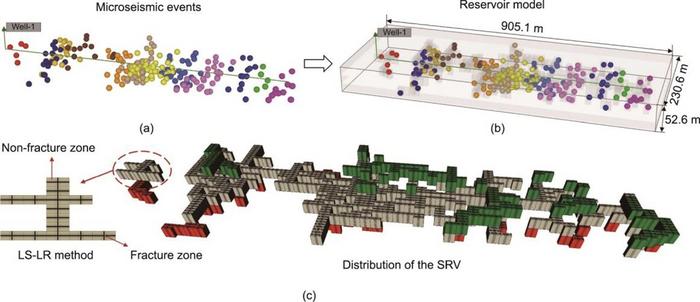In recent years, the increasing emphasis on climate change and its detrimental effects has led to a greater interest in carbon capture, utilization, and storage (CCUS) technologies. Among these, CO2-enhanced oil recovery (CO2-EOR) stands out as a viable method not only for boosting oil production but also for reducing atmospheric carbon. A fascinating new study has emerged in the journal Engineering, delving deep into the intricacies of cyclic CO2 injection in unconventional reservoirs, specifically targeting the Triassic Baikouquan formation in the Mahu Sag. The research aims to elucidate how effective CO2-EOR and geological storage can be achieved in complex reservoir systems characterized by tight and shale oil.
The research is spearheaded by prominent scientists Bing Wei and Valeriy Kadet, whose innovative approach integrates advanced software tools such as CMG-GEM to generate a robust reservoir model. This model incorporates a multitude of critical factors, including CO2 solubility, molecular diffusion, geochemical reactions, and the sensitivity of rock to stress. By calibrating the model with empirical data, the researchers have ensured that the predictions made are not just theoretical but represent real-world scenarios. This meticulous approach highlights the researchers’ commitment to creating practical solutions for enhancing oil recovery while minimizing environmental impact.
Cyclic CO2 injection is a technique designed to optimize CO2 utilization and decomposition within the reservoir environment. This process entails alternating between CO2 injection and production cycles, allowing for the dynamic interaction between CO2, crude oil, and geological structures. The uniqueness of this study lies in its comparative analysis of two distinct scenarios: the first being the exclusive consideration of CO2-crude oil interactions, and the second encompassing all mechanisms of CO2 storage. Through this comparative lens, the researchers were able to identify the effects of CO2 storage on oil recovery.
The experimental results are noteworthy, revealing that after ten cycles of CO2 injection, the optimized process yielded a 3.4% increase in oil recovery relative to the original oil in place (OOIP). This statistic highlights the potential efficacy of CO2-EOR methodologies in tight reservoirs. Furthermore, it was found that almost half of the injected CO2—approximately 48.3%—was sequestered underground, demonstrating a dual benefit of oil recovery and carbon storage.
However, the study also uncovers an intriguing trade-off. While CO2 storage improves overall carbon retention, it simultaneously impacts CO2-oil interactions. The researchers quantified this phenomenon, noting a 25.9% reduction in the CO2-oil mixing zone and a corresponding 2.2% decline in cumulative oil production. This observation indicates that while the goals of carbon storage are being met, a careful equilibrium must be maintained to ensure optimal oil recovery is not sacrificed in the process.
A deeper analysis of CO2 migration and transformation further enriches this study. It sheds light on the various forms in which CO2 can be stored—ranging from dissolved CO2 in oil and water to mineralized carbonates. The unique cyclical nature of the injection process significantly alters these storage forms. For instance, researchers identified that dissolved CO2 in the oil accounted for more than fifty percent of total CO2 retention; however, this also poses a risk of CO2 being released back during the production phase, which could undermine the very goals the study aims to achieve.
Another critical aspect examined in this research pertains to the geochemical reactions and changes in porosity and permeability of the reservoir following CO2 injection cycles. The results indicated that mineral dissolution and precipitation had profound effects on reservoir characteristics. In the ten cycles analyzed, porosity slightly diminished—0.86% in non-fractured zones and 0.81% in fractured areas—while permeability likewise showed modest reductions of 2.51% and 2.39%. Such changes could have significant implications for future CO2-EOR endeavors, highlighting the need for comprehensive long-term studies in various geologic settings.
Despite the promising findings, the researchers acknowledge limitations in their study, indicating that certain elements, such as the simplification of the geomechanical module and the uncertainty surrounding the reactive surface area (RSA) parameters, warrant further investigation. Such reflections emphasize the nuanced nature of geological processes and the complexity involved in optimizing CCUS methodologies.
This groundbreaking research, titled “CO2 Utilization and Geological Storage in Unconventional Reservoirs After Fracturing,” not only expands our understanding of CO2 dynamics within tight oil reservoirs but also lays the groundwork for future innovations in CCUS-EOR technology. The implications of this work extend beyond academic circles, offering strategic insights for industry practitioners and policymakers aiming to implement effective carbon management strategies.
In a climate-stricken world increasingly opting for cleaner energy solutions, the technologies surrounding CO2 management hold paramount importance. This study stands as a crucial contribution to the conversation surrounding climate-friendly oil recovery practices while promoting a balanced approach to industrial energy needs and environmental stewardship.
As we continue on the path towards deeper understanding and innovation in reservoir studies, research like that of Wei and Kadet is essential. It provides a blueprint for future efforts focused on both enhancing oil recovery and achieving substantial reductions in greenhouse gas emissions. With ongoing developments and more rigorous studies, the field is poised for growth, offering hope that the dual goals of increased energy production and climate change mitigation can be realized.
Subject of Research: Cyclic CO2 Injection in Unconventional Reservoirs
Article Title: CO2 Utilization and Geological Storage in Unconventional Reservoirs After Fracturing
News Publication Date: 17-Jan-2025
Web References: https://doi.org/10.1016/j.eng.2025.01.005
References: N/A
Image Credits: Jinzhou Zhao et al.
Keywords: Carbon capture, Geochemistry, Climate change mitigation, Climate modeling




